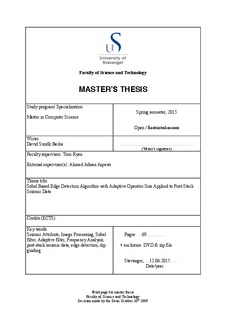| dc.contributor.author | Barka, David | |
| dc.date.accessioned | 2015-09-11T10:49:16Z | |
| dc.date.available | 2015-09-11T10:49:16Z | |
| dc.date.issued | 2015-06-12 | |
| dc.identifier.uri | http://hdl.handle.net/11250/299559 | |
| dc.description | Master's thesis in Computer science | nb_NO |
| dc.description.abstract | Exploring the subsurface is today mostly done by researching seismic imaging thoroughly before attempting to bore exploration wells. By applying seismic attributes (imaging filters), we can highlight certain aspects of the seismic, which will help geoscientists to determine with better certainty potential reservoirs. Faults are an important feature in reservoir identification as oil is likely to emigrate via them. By highlighting faults with seismic attribute, it is possible to create three-dimensional models and through advance simulations a better understanding is achieved. However, achieving a detailed image of a faulted area can be difficult as larger faults can overshadow minor faults, parallel or perpendicular. This is especially hard considering a static filter operator size that can be too large to pick up the smaller faults.
In this work, we propose to adjust the filter operator size according to the frequency content of the seismic, by adapting the operator size according to the current filter position. We aim to achieve higher amounts of detail in fault detection using a method based on the Sobel method. We will also investigate the chaotic nature of the seismic to determine if the use of dip correction is needed. These are all novel methods in the approach to fault estimation in seismic.
Our implementation is done in MATLAB and tested on a dataset in the North Sea offshore Netherlands, F3, which has a heavily faulted area due to salt tectonics. We perform a vertical frequency analysis using the discrete Fourier transform to determine an operator size that is used in a horizontal frequency analysis using variance. To avoid picking up stratigraphy, we use dip guiding that let us filter along the different layers of the earth. This helps avoid geological noise detection. However, in chaotic areas, such as salt domes, we avoid using dip guided filtering, as there are no layers to follow, leading to a possible false representation. With the use of linear interpolation, we want to capture small details that otherwise would be absent. To better represent the faults in our image, we apply a vertical mean smoothing filter with neighboring values. This works due to the vertical nature of fault features. Evaluating all the stages in our algorithm, we find that the computational complexity is bounded by O(N2).
The approach of an adaptive operator size for a Sobel based edge detection to achieve a more detailed image proves to be successful as it surpasses the industry standard for fault detection. Some of the larger faults are weaker in value than in Petrel. However, the noise in between the faults has been reduced substantially and smaller faults parallel and perpendicular have emerged. Ultimately giving a more realistic and complete representation of the fault networks present in the sub-surface. | nb_NO |
| dc.language.iso | eng | nb_NO |
| dc.publisher | University of Stavanger, Norway | nb_NO |
| dc.relation.ispartofseries | Masteroppgave/UIS-TN-IDE/2015; | |
| dc.rights | Navngivelse-Ikkekommersiell-IngenBearbeidelse 3.0 Norge | * |
| dc.rights.uri | http://creativecommons.org/licenses/by-nc-nd/3.0/no/ | * |
| dc.subject | informasjonsteknologi | nb_NO |
| dc.subject | datateknikk | nb_NO |
| dc.subject | post - stack seismic data | nb_NO |
| dc.subject | image processing | nb_NO |
| dc.title | Sobel based edge detection algorithm with adaptive operator size applied to post-stack seismic data | nb_NO |
| dc.type | Master thesis | nb_NO |
| dc.subject.nsi | VDP::Technology: 500::Information and communication technology: 550::Computer technology: 551 | nb_NO |

